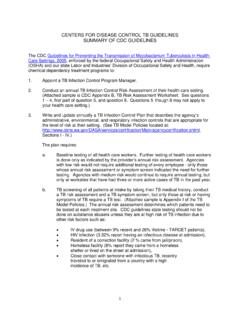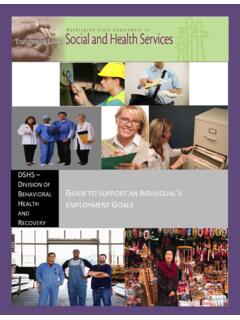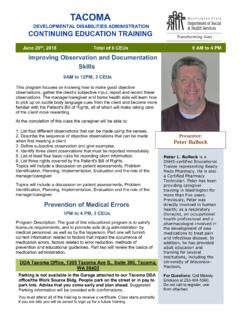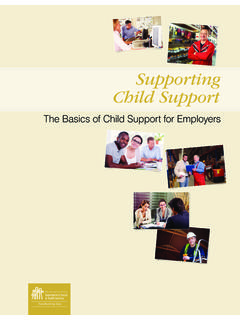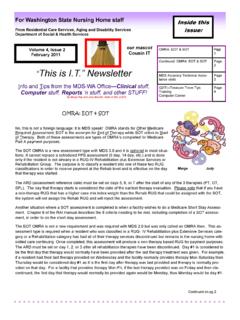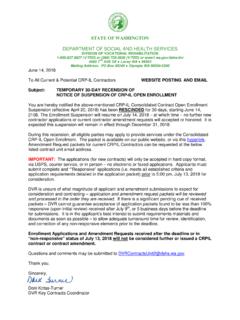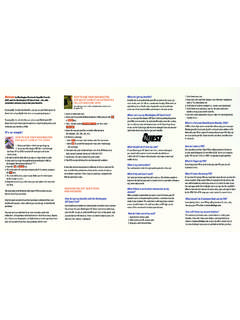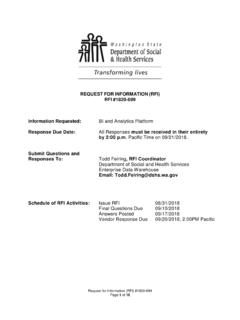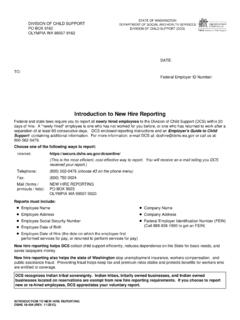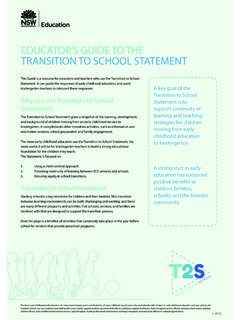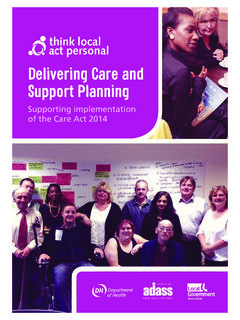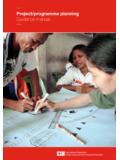Transcription of Cultural Competence Planning Guide - Transforming Lives
1 Cultural Competence Planning Guide Cultural Competence Workgroup 2011-2014. TABLE OF CONTENTS. EXECUTIVE SUMMARY: POLICY AND OVERVIEW.. 1. Policy.. 1. The DSHS vision of Cultural Competence .. 1. Who should implement these guidelines? .. 1. INDIVIDUAL services AND Cultural Competence .. 1. Incremental approach.. 1. What is Cultural Competence ?.. 2. Organization and administrative support.. 2. MODEL FOR Cultural Competence Planning .. 2. SMART Goals.. 2. SMART Objectives.. 2. GOALS APPLICABLE FOR Cultural Competence .. 3. Cultural Competence Planning worksheet..3. Outline of goals and sample objectives.. 3. ACTION AND Planning Guide .. 4. Cultural Competence is programmatic Competence .. 4. How to become more culturally competent?.. 4. Cultural Competence is both personal and organizational .. 4. Who can receive culturally competent services ?.. 4. Individualized services .. 4. Is Cultural Competence aimed at the provider or the administration?.. 4.
2 COMPONENTS OF CULTURALLY COMPETENT PLANS.. 5. Human Resources Development.. 5. CITATIONS.. 6. FREQUENTLY ASKED QUESTIONS.. 6. What is Diversity?.. 6. Why is inclusion important? .. 6. What is culture? .. 7. RESOURCES.. 8. ACKNOWLEDGMENTS.. 9. EXECUTIVE SUMMARY: POLICY AND OVERVIEW. Policy The washington State department of social and health services is committed to creat- ing and maintaining an environment that supports Cultural Competence by promot- ing respect and understanding of diverse cultures, social groups, and individuals. To Transforming Lives achieve this commitment, we develop and maintain a high-performing workforce that improves outcomes for clients, delivers culturally responsive services , and reflects the diversity of the communities we serve. We deliver culturally responsive services and our TOGETHER WE WILL. workforce reflects the diversity of the communities we serve. Each DSHS administration decrease poverty improve ensures Cultural Competence is integrated into the overall organizational culture and the safety and health ongoing business.
3 Status of people increase Policy , Cultural Competence , applies to all administrations and employees and educational and employment those providing contractual services on behalf of the department of social and health success support people services . The department of social and health services will continue to enhance its and communtieis in reaching knowledge in Cultural Competence . Each administration will develop an action plan that their potential supports and guides staff by ensuring that they have a means of achieving: culturally competent personnel culturally appropriate services culturally competent organizations While each administration is responsible for developing and implementing their indi- vidual plans to enhance and support Cultural Competence as it pertains to their specific workforce, the Office of Diversity, Equity and Inclusion is responsible for creating Guide - lines to enhance and support Cultural Competence within the department .
4 The Office of DSHS CLIENTS AS A Diversity, Equity and Inclusion will ensure standardization by reviewing each administra- PERCENT OF THE CASELOAD tion's plan and providing feedback regarding the thoroughness and implementation All DSHS Programs, statewide strategy of each plan. All levels of management are expected to implement and support 2008 data activities that enhance the Cultural Competence of their staff. 61% The DSHS vision of Cultural Competence : Continuous self-assessment Applying strategies to mediate and resolve conflicts and misunderstandings that 39% stem from Cultural differences. DETAIL: Specific Minority Expanding employees' Cultural Competence and adapting services to meet culturally unique needs. 20% Developing effective service delivery that includes input from culturally diverse com- munities and individuals 9%. 6% 6% Advocating for and supporting culturally competent and responsive programs. Measuring the impact that services have on culturally diverse populations White Any Hispanic African Am.
5 Asian/. Only Minority All Races Am. Indian/ Pacific Non- Hispanic AK. Native Islander Who should implement these guidelines? Data courtesy Research and Data Analysis DSHS administrations and health care providers may be familiar with the national stan- DATA SOURCE: washington State department of social and health services , Planning , Performing and Accountability, Research and dards on Culturally and Linguistically Appropriate services for Cultural Competence . The Data Analysis Division, Client services Database, August 9, 2010. Population use rates were calculated based on categories provided Planning Guide is consistent with the Culturally and Linguistically Appropriate services by the department of health . NOTE: We have used percentages for clients only when race is standards but goes further to support direct case work by agency staff. known. Counts include Support Enforcement only clients for all years provided. Since a person can be a member of more than one The Planning Guide is not a mandate but is designed as an educational tool that answers the minority group, the percents for individual racial categories will sum more than percent shown for any minority.
6 White only and question: How do we become more culturally competent? any minority sum to 100 percent. INDIVIDUAL services AND Cultural Competence . Incremental approach Cultural Competence is a developmental process, a goal that professionals and organiza- tions strive to achieve. This Guide envisions an incremental approach toward Cultural Competence based on sustained, achievable actions with realistic timelines. This Guide serves to assist DSHS administrations in developing and implementing their own Cultural Competence plans. C U LT U R A L CO M PE T E N C E PL A N N I N G G U I DA N C E 1. What is Cultural Competence ? Cultural Competence is the behaviors of individuals and the department 's policies that come together enabling individuals to work effectively in cross- Cultural situations. It promotes respect and understanding of diverse cultures and social groups, and an appreciation of each individual's unique attributes. It includes the ability and the will to respond to the unique needs of an individual client that arise from the client's culture, and the ability to use the person's culture as a resource or tool to assist in interventions to help meet the person's needs.
7 Organization and administration support Data, assistance with Planning and goal setting Website resources A MODEL FOR Cultural Competence Planning . The six areas of action described in this Guide can serve as a framework for a Cultural Competence plan. The model is based on the Culturally Linguistic and Appropriate Ser- vices standards that are divided into six core areas. The areas point to goals, key objec- tives, and offer ideas for tasks within each objective. As you develop your own Cultural Inclusion is not a strat- Competence plan, the six areas for Culturally Linguistic and Appropriate services action egy to help people fit can serve as a model. Use the worksheet on the following page to develop your own plan. into the systems and structures that exist in our societies; it is about SMART is a term used in project management that offers Transforming those sys- a way to evaluate how realistic and achievable objectives tems and structures to are.
8 SMART objectives are: make it better for every- Specific Clear and detailed about what you would like to one. Inclusion is about accomplish. Who is the target population? What creating a better world will be accomplished? Who is doing what to for everyone. whom? Diane Richler, President, Measurable Specific ways to ensure progress. How much Inclusion International change is expected? Sometimes qualitative objectives can be measured with a yes or no.. Achievable Can realistically be accomplished with the resources you have. Relevant Makes a difference, and makes sense. Timely Linked to time limits and deadlines. 2 C U LT U R A L CO M PE T E N C E PL A N N I N G G U I DA N C E. GOALS APPLICABLE TO Cultural Competence . Foster Cultural Build Community Collect Diversity Data Measure Performance Reflect and Respect Ensure Effective Competence Partnerships and Evaluate Results Diversity Communication and Language Access OBJECTIVES. (Programs can choose from this list or develop their own objectives).
9 1. Understand the need 1. Partner with commu- 1. Identify key popula- 1. Appoint a Cultural com- 1. Reflect diversity 1. Identify LEP clients for Cultural Competence nity organizations by tions that are frequently petence committee. through focus on CC. through referral by reviewing agency- asking stakeholders to served by agency. sources and at ap- assessment. dialog about CC and 2. Assess Cultural compe- 2. Recruit diverse plication for service. assessment results. 2. Standardize Race tence (use self-assess- employees. 2. Train staff on Cultural Ethnicity and Language ment as baseline). 2. Assess services and Competence based on 2. Involve the community (REL) data collection. 3. Retain and promote language needs. self-assessment. through community 3. Frame CLAS within diverse employees with outreach, health centers, 3. Integrate data collec- vision and goals of the recruiting plan. 3. Plan Identify some 3. Develop employees' religious institutions, tion into frameworks.
10 Division, areas, units. key activities for next knowledge, skills 4. Respond to concerns year. community centers, 4. Assess needs and areas 4. Identify and Develop using MI principles. and self-awareness and community-based through Motivational for improvement by sur- Metrics: Who was 4. Deliver effective lan- organiztions. veying referral sources. served where and by 5. Resolve and prevent guage access services Interviewing training. cross- Cultural conflicts 3. Engage people: clients, whom. using DSHS resources 4. Deliver culturally 5. Share relevant data by using Non-Violent for interpreters and stakeholders, contractor with the community at 5. Evaluate progress: Communication competent service as on subject of CC. printed materials. measured by customer stakeholder meetings Analyze performance principles. survey. 4. Share Cultural compe- and area staff meetings. data from lens of CC. 5. Adapt programs to tence knowledge and LEP populations and 6.
